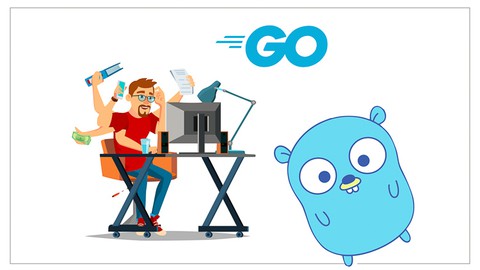
Up and Running with Concurrency in Go (Golang)
Up and Running with Concurrency in Go (Golang), available at $74.99, has an average rating of 4.75, with 40 lectures, 6 quizzes, based on 231 reviews, and has 6281 subscribers.
You will learn about Fundamentals of concurrency – what it is, how it works in any language The complete set of tools and techniques for implementing concurrency with the Go programming language Confidence, experience and sample code to quickly implement concurrency into your own projects. Downloadable resources include dozens of code samples, course slides, cheat sheets and more. Coding challenge exercises after each major section to immediately use your new skills. Concurrency, parallelism, IO bound vs CPU bound code, goroutines, wait groups, channels, race conditions, mutexes, condition variables, and more This course is ideal for individuals who are Anyone getting started with concurrency and specifically within the Go programming language. or Those who wish to learn the essentials of concurrent programming in the Go programming language. It is particularly useful for Anyone getting started with concurrency and specifically within the Go programming language. or Those who wish to learn the essentials of concurrent programming in the Go programming language.
Enroll now: Up and Running with Concurrency in Go (Golang)
Summary
Title: Up and Running with Concurrency in Go (Golang)
Price: $74.99
Average Rating: 4.75
Number of Lectures: 40
Number of Quizzes: 6
Number of Published Lectures: 40
Number of Published Quizzes: 6
Number of Curriculum Items: 46
Number of Published Curriculum Objects: 46
Original Price: $29.99
Quality Status: approved
Status: Live
What You Will Learn
- Fundamentals of concurrency – what it is, how it works in any language
- The complete set of tools and techniques for implementing concurrency with the Go programming language
- Confidence, experience and sample code to quickly implement concurrency into your own projects.
- Downloadable resources include dozens of code samples, course slides, cheat sheets and more.
- Coding challenge exercises after each major section to immediately use your new skills.
- Concurrency, parallelism, IO bound vs CPU bound code, goroutines, wait groups, channels, race conditions, mutexes, condition variables, and more
Who Should Attend
- Anyone getting started with concurrency and specifically within the Go programming language.
- Those who wish to learn the essentials of concurrent programming in the Go programming language.
Target Audiences
- Anyone getting started with concurrency and specifically within the Go programming language.
- Those who wish to learn the essentials of concurrent programming in the Go programming language.
Are you ready to tackle one of the most exciting and important features of the Go language?
According to the most recent developer surveys, Go(lang) is one of the world’s most desired and loved languages, and its developers are among the highest paid in the world. Go is also the top language that companies are planning to migrate to, meaning that your Go skills are likely future-proof for many years to come.
Concurrency is considered to be a very advanced topic within Golang, and some comprehensive Go courses do not address it at all. Yet we believe that with just a reasonable number of hours of effort, you can be on your way, comfortable with concurrency and ready to add asynchronous features to your next programming project.
This course is for ANYONE getting started with concurrency, especially in the Go programming language. There are no strict prerequisites, but knowledge of computer programming principles and specifically the Go language will be very helpful, especially for the coding exercises.
This relatively short course covers ALL the essentials of concurrency – theory, syntax, coding examples, and downloadable copies of all visual materials.
Specifically, we will cover:
-
Concurrency theory, terminology, trends, benefits, and challenges
-
The difference between concurrency and parallelism / parallel programming
-
Goroutines
-
Blocking code
-
Wait groups
-
Channels
-
IO bound vs CPU bound code with examples of each
-
Race conditions
-
Mutexes
-
Condition variables
-
Atomic variables
-
Concurrency patterns
This course is offered at an affordable price, saving you weeks or months of digging through YouTube videos or purchasing other courses just to get up and running with concurrency.
Enroll today and be on your way! See you soon.
From recent students:
“The instructor is very enthusiastic and knowledgeable. His presentations are clear and concise. Will seek out more courses from this instructor.”
“Here’s one of those courses that are short and sweet while covering the exact content you came for. Stan Vangilder delivers valuable, practical teachings on turning synchronous processes into fast, concurrent processes. One thing I appreciated from this course was gaining an in-depth understanding of how Golang differs from other languages when it comes to native support for concurrency for both IO-bound and CPU-bound processes. Plus, ‘atomic variables’ are no longer just a cool sounding piece of code I will skip over and learn about one day. Thanks, Stan!”
“This exceptional course is exactly what I needed. Thank you so much Stan for explaining in such detailed manner and providing wonderful and easy to follow examples. I truly enjoyed this course and binged watched it like a Netflix show. I learned a lot. Really looking forward for your next courses with Go!”
“Awesome! the author has a nice tone of voice which makes easy to follow the topics. The examples used are excellent the understand the concepts, I highly recommend this course.”
“Sir, that was a wonderful course, 5 stars easily. Are you planning on making other courses with Go?”
“Great instructor! I look forward to more courses from him. Thanks”
“I finished the course in a few hours and left u my feedback there, it’s good content! Congratulations and let us know when u publish ur next course!”
Course Curriculum
Chapter 1: Welcome and Course Qverview
Lecture 1: Welcome! I'm glad you're here
Lecture 2: Course Introduction
Lecture 3: Course resources will be available soon, downloaded in Section 3
Lecture 4: Quick Concurrency Demo
Lecture 5: How this course works
Lecture 6: Classroom Overview
Chapter 2: Understanding Concurrency – Trends, Benefits and Challenges
Lecture 1: Everyday Concurrency
Lecture 2: Understanding the Terminology
Lecture 3: Trend #1 – Latency
Lecture 4: Trend #2 – Multiple CPU Cores
Lecture 5: Summary of Benefits and Challenges
Chapter 3: Setting Up Your Custom Development Environment
Lecture 1: Installing Go, Course Resources and Your IDE
Lecture 2: Using Multiple Screens and Other Physical Considerations
Lecture 3: Download or RE-Download Course Resources
Chapter 4: Creating Your First Goroutine
Lecture 1: Let's try it….
Chapter 5: Understanding Blocking Code
Lecture 1: What exactly does "blocking" mean?
Chapter 6: Using Wait Groups to Track Goroutine Status
Lecture 1: Wait Groups Overview
Lecture 2: Coding Example
Lecture 3: CODING EXERCISE: Wait Groups
Chapter 7: Using Channels to Communicate with Goroutines
Lecture 1: Purpose and Syntax Overview
Lecture 2: Using Channels in our Code
Lecture 3: Using Channels to Synchronize Goroutines
Lecture 4: Q&A: Why and how did we use wait groups in sync3 and sync4?
Lecture 5: CODING EXERCISE: Channels
Chapter 8: Understanding IO-bound vs CPU-bound Processes
Lecture 1: IO-bound vs CPU-bound Intro
Lecture 2: CPU-bound Demos
Lecture 3: IO-bound Demos
Lecture 4: IO-bound vs CPU-bound Summary
Lecture 5: CODING EXERCISE: Understanding len and range with concurrency
Chapter 9: What could go wrong? Race Conditions: mutexes, condition and atomic variables
Lecture 1: Race Condition Intro Demo
Lecture 2: Race Condition Intro
Lecture 3: Race Condition Solutions – Mutex, Atomic Variables
Lecture 4: Race Condition Solution Demo
Lecture 5: Condition Variables Demo
Lecture 6: CODING EXERCISE: Using channels instead of sharing variables
Chapter 10: Concurrency Patterns
Lecture 1: Worker Pools Intro
Lecture 2: Worker Pools Demo
Chapter 11: Wrap Up! and Closing Credits
Lecture 1: Congratulations!
Lecture 2: Reminder of course resources…
Lecture 3: Closing Credits
Instructors
-

Stan Vangilder
Computer Engineer, Instructor, Developer
Rating Distribution
- 1 stars: 1 votes
- 2 stars: 0 votes
- 3 stars: 11 votes
- 4 stars: 56 votes
- 5 stars: 163 votes
Frequently Asked Questions
How long do I have access to the course materials?
You can view and review the lecture materials indefinitely, like an on-demand channel.
Can I take my courses with me wherever I go?
Definitely! If you have an internet connection, courses on Udemy are available on any device at any time. If you don’t have an internet connection, some instructors also let their students download course lectures. That’s up to the instructor though, so make sure you get on their good side!
You may also like
- Digital Marketing Foundation Course
- Google Shopping Ads Digital Marketing Course
- Multi Cloud Infrastructure for beginners
- Master Lead Generation: Grow Subscribers & Sales with Popups
- Complete Copywriting System : write to sell with ease
- Product Positioning Masterclass: Unlock Market Traction
- How to Promote Your Webinar and Get More Attendees?
- Digital Marketing Courses
- Create music with Artificial Intelligence in this new market
- Create CONVERTING UGC Content So Brands Will Pay You More
- Podcast: The top 8 ways to monetize by Podcasting
- TikTok Marketing Mastery: Learn to Grow & Go Viral
- Free Digital Marketing Basics Course in Hindi
- MailChimp Free Mailing Lists: MailChimp Email Marketing
- Automate Digital Marketing & Social Media with Generative AI
- Google Ads MasterClass – All Advanced Features
- Online Course Creator: Create & Sell Online Courses Today!
- Introduction to SEO – Basic Principles of SEO
- Affiliate Marketing For Beginners: Go From Novice To Pro
- Effective Website Planning Made Simple




















